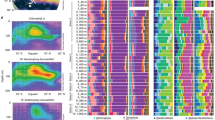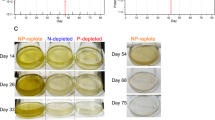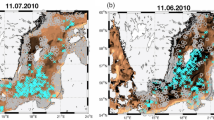Abstract
In coastal waters worldwide, an increase in frequency and intensity of algal blooms has been attributed to eutrophication, with further increases predicted because of climate change. Yet, the cellular-level changes that occur in blooming algae remain largely unknown. Comparative metatranscriptomics was used to investigate the underlying molecular mechanisms associated with a dinoflagellate bloom in a eutrophied estuary. Here we show that under bloom conditions, there is increased expression of metabolic pathways indicative of rapidly growing cells, including energy production, carbon metabolism, transporters and synthesis of cellular membrane components. In addition, there is a prominence of highly expressed genes involved in the synthesis of membrane-associated molecules, including those for the production of glycosaminoglycans (GAGs), which may serve roles in nutrient acquisition and/or cell surface adhesion. Biotin and thiamine synthesis genes also increased expression along with several cobalamin biosynthesis-associated genes, suggesting processing of B12 intermediates by dinoflagellates. The patterns in gene expression observed are consistent with bloom-forming dinoflagellates eliciting a cellular response to elevated nutrient demands and to promote interactions with their surrounding bacterial consortia, possibly in an effort to cultivate for enhancement of vitamin and nutrient exchanges and/or direct consumption. Our findings provide potential molecular targets for bloom characterization and management efforts.
Similar content being viewed by others
Log in or create a free account to read this content
Gain free access to this article, as well as selected content from this journal and more on nature.com
or
References
Alexander H, Jenkins BD, Rynearson TA, Dyhrman ST . (2015). Metatranscriptome analyses indicate resource partitioning between diatoms in the field. Proc Natl Acad Sci USA 112: 201421993.
Allen AE, Dupont CL, Oborník M, Horák A, Nunes-Nesi A, McCrow JP et al. (2011). Evolution and metabolic significance of the urea cycle in photosynthetic diatoms. Nature 473: 203–207.
Amin SA, Hmelo LR, van Tol HM, Durham BP, Carlson LT, Heal KR et al. (2015). Interaction and signalling between a cosmopolitan phytoplankton and associated bacteria. Nature 522: 98–101.
Amo M, Suzuki N, Kawamura H, Yamaguchi A, Takano Y, Horiguchi T . (2010). Sterol composition of dinoflagellates: different abundance and composition in heterotrophic species and resting cysts. Geochem J 44: 225–231.
Anderson DM, Burkholder JM, Cochlan WP, Glibert PM, Gobler CJ, Heil CA et al. (2008). Harmful algal blooms and eutrophication: examining linkages from selected coastal regions of the United States. Harmful Algae 8: 39–53.
Arends SJR, Kustusch RJ, Weiss DS . (2009). ATP-binding site lesions in FtsE impair cell division. J Bacteriol 191: 3772–3784.
Bertrand EM, Allen AE, Dupont CL, Norden-Krichmar TM, Bai J, Valas RE et al. (2012). PNAS Plus: influence of cobalamin scarcity on diatom molecular physiology and identification of a cobalamin acquisition protein. Proc Natl Acad Sci USA 109: E1762–E1771.
Bertrand EM, Moran DM, Mcilvin MR, Hoffman JM, Allen AE, Saito MA . (2013). Methionine synthase interreplacement in diatom cultures and communities: Implications for the persistence of B 12 use by eukaryotic phytoplankton. Limnol Oceanogr 58: 1431–1450.
Bisicchia P, Noone D, Lioliou E, Howell A, Quigley S, Jensen T et al. (2007). The essential YycFG two-component system controls cell wall metabolism in Bacillus subtilis. Mol Microbiol. 65: 180–200.
Bollivar DW . (2006). Recent advances in chlorophyll biosynthesis. Photosynth Res 90: 173–194.
Bosak S, Pletikapić G, Hozić A, Svetličić V, Sarno D, Viličić D . (2012). A novel type of colony formation in marine planktonic diatoms revealed by atomic force microscopy. PLoS One 7: e44851.
Cole JJ . (1982). Interactions between bacteria and algae in aquatic ecosystems. Annu Rev Ecol Syst 13: 291–314.
Cooper MB, Smith AG . (2015). Exploring mutualistic interactions between microalgae and bacteria in the omics age. Curr Opin Plant Biol 26: 147–153.
Cooper ED, Bentlage B, Gibbons TR, Bachvaroff TR, Delwiche CF . (2014). Metatranscriptome profiling of a harmful algal bloom. Harmful Algae 37: 75–83.
Coschigano KT, Melo-Oliveira R, Lim J, Coruzzi GM . (1998). Arabidopsis gls mutants and distinct Fd-GOGAT genes. Implications for photorespiration and primary nitrogen assimilation. Plant Cell 10: 741–752.
Croft MT, Lawrence AD, Raux-Deery E, Warren MJ, Smith AG . (2005). Algae acquire vitamin B12 through a symbiotic relationship with bacteria. Nature 438: 90–93.
Croft MT, Warren MJ, Smith AG . (2006). Algae need their vitamins. Eukaryot Cell 5: 1175–1183.
Daugbjerg N, Hansen G, Larsen J, Moestrup Ø . (2000). Phylogeny of some of the major genera of dinoflagellates based on ultrastructure and partial LSU rDNA sequence data, including the erection of three new genera of unarmoured dinoflagellates. Phycologia 39: 302–317.
Decho AW . (2000). Microbial biofilms in intertidal systems: an overview. Cont Shelf Res 20: 1257–1273.
Delbarre-Ladrat C, Sinquin C, Lebellenger L, Zykwinska A, Colliec-Jouault S . (2014). Exopolysaccharides produced by marine bacteria and their applications as glycosaminoglycan-like molecules. Front Chem 2: 1–15.
Giordano M, Beardall J, Raven JA . (2005). CO2 concentrating mechanisms in algae: mechanisms, environmental modulation, and evolution. Annu Rev Plant Biol 56: 99–131.
Haimovich-Dayan M, Garfinkel N, Ewe D, Marcus Y, Gruber A, Wagner H et al. (2013). The role of C4 metabolism in the marine diatom Phaeodactylum tricornutum. New Phytol 197: 177–185.
Hallegraeff GM . (1992). Harmful algal blooms in the Australian region. Mar Pollut Bull 25: 186–190.
Heimann K . (2012). Gymnodinium and related dinoflagellates. eLS Available at: http://www.els.net/WileyCDA/ElsArticle/refId-a0001967.html (last accessed 28 September 2015).
Helliwell KE, Wheeler GL, Leptos KC, Goldstein RE, Smith AG . (2011). Insights into the evolution of vitamin B12 auxotrophy from sequenced algal genomes. Mol Biol Evol 28: 2921–2933.
Jeong HJ, Yoo YD, Kim JS, Seong KA, Kang NS, Kim TH . (2010). Growth, feeding and ecological roles of the mixotrophic and heterotrophic dinoflagellates in marine planktonic food webs. Ocean Sci J 45: 65–91.
Kang L-K, Gong G-C, Wu Y-H, Chang J . (2015). The expression of nitrate transporter genes reveals different nitrogen statuses of dominant diatom groups in the southern East China Sea. Mol Ecol 24: 1374–1386.
Katoh H, Hagino N, Grossman AR, Ogawa T . (2001). Genes essential to iron transport in the cyanobacterium Synechocystis sp. strain PCC 6803. J Bacteriol 183: 2779–2784.
Kiørboe T, Andersen KP, Dam HG . (1990). Coagulation efficiency and aggregate formation in marine phytoplankton. Mar Biol 107: 235–245.
de Leeuw E, Graham B, Phillips GJ, ten Hagen-Jongman CM, Oudega B, Luirink J . (1999). Molecular characterization of Escherichia coli FtsE and FtsX. Mol Microbiol 31: 983–993.
Lidie KB, van Dolah FM . (2007). Spliced leader RNA-mediated trans-splicing in a dinoflagellate, Karenia brevis. J Eukaryot Microbiol 54: 427–435.
Lima-mendez G, Faust K, Henry N, Decelle J, Colin S, Carcillo F et al. (2015). Determinants of community structure in the global plankton interactome. Ocean Plankton 348: 1–10.
Lin S, Zhang H, Zhuang Y, Tran B, Gill J . (2010). Spliced leader-based metatranscriptomic analyses lead to recognition of hidden genomic features in dinoflagellates. Proc Natl Acad Sci USA 107: 20033–20038.
Litaker RW, Tester PA, Duke CS, Kenney BE, Pinckney JL, Ramus J . (2002). Seasonal niche strategy of the bloom-forming dinoflagellate Heterocapsa triquetra. Mar Ecol Prog Ser 232: 45–62.
Luettich RA Jr, McNinch JE, Paerl HW, Peterson CH, Wells JT, Alperin M et al. (2000). Neuse River Estuary modeling and monitoring project. Water Resources Research Institute of the University of North Carolina. Available at http://www.lib.ncsu.edu/resolver/1840.4/1891.
Maheswari U, Jabbari K, Petit J-L, Porcel BM, Allen AE, Cadoret J-P et al. (2010). Digital expression profiling of novel diatom transcripts provides insight into their biological functions. Genome Biol 11: R85.
Marchetti A, Maldonado MT . (2016) Iron. In: Borowitzka MA, Beardall J, Raven JA (eds), The Physiology of Microalgae. Springer International Publishing: Cham, Switzerland, pp 233–279.
Marchetti A, Schruth DM, Durkin CA, Parker MS, Kodner RB, Berthiaume CT et al. (2012). Comparative metatranscriptomics identifies molecular bases for the physiological responses of phytoplankton to varying iron availability. Proc Natl Acad Sci USA 109: E317–E325.
Moestrup Ø, Hakanen P, Hansen G, Daugbjerg N, Ellegaard M . (2014). On Levanderina fissa gen. & comb. nov. (Dinophyceae) (syn. Gymnodinium fissum Gyrodinium instriatum Gyr. uncatenum, a dinoflagellate with a very unusual sulcus. Phycologia 53: 265–292.
Van Mooy BAS, Rocap G, Fredricks HF, Evans CT, Devol AH . (2006). Sulfolipids dramatically decrease phosphorus demand by picocyanobacteria in oligotrophic marine environments. Proc Natl Acad Sci USA 103: 8607–8612.
Müller-MNiklas G, Stefan S, Kaltenböok E, Herndl GJ . (1994). Organic content and bacterial metabolism in amorphous aggregations of the northern Adriatic Sea. Limnol Oceanogr 39: 58–68.
Myklestad SM . (1995). Release of extracellular products by phytoplankton with special emphasis on polysaccharides. Sci Total Environ 165: 155–164.
Myklestad SM . (1999). Phytoplankton extracellular production and leakage with considerations on the polysaccharide accumulation. Ann Super Sanita 35: 401–404.
Myklestad SM . (2000). Dissolved organic carbon from phytoplankton. Mar Chem 5: 112–144.
Nielsen R, Bustamante C, Clark AG, Glanowski S, Sackton TB, Hubisz MJ et al. (2005). A scan for positively selected genes in the genomes of humans and chimpanzees. PLoS Biol 3: e170.
Nishibori N, Nishijima T . (2004). Changes in polyamine levels during growth of a red-tide causing phytoplankton Chattonella antiqua (Raphidophyceae). Eur J Phycol 39: 51–55.
Nishibori N, Nishio S . (1997). Occurrence of polyamines in the broom forming toxic dinoflagellate Alexandrium tamarense Naoyoshi and Sachio Key words: Alexandrium late. The peaks corresponding to putrescine and spermidine benzoates in HPLC analysis were subjected to LC/FABMS analysis. Fish Sci 63: 319–320.
Okuhara H, Matsumura T, Fujita Y, Hase T . (1999). Cloning and inactivation of genes encoding ferredoxin- and NADH-dependent glutamate synthases in the cyanobacterium Plectonema boryanum. Imbalances in nitrogen and carbon assimilations caused by deficiency of the ferredoxin-dependent enzyme. Plant Physiol 120: 33–42.
Paerl HW . (2006). Assessing and managing nutrient-enhanced eutrophication in estuarine and coastal waters: interactive effects of human and climatic perturbations. Ecol Eng 26: 40–54.
Paerl HW, Pinckney JL, Fear J, Peierls BL . (1998). Ecosystem responses to internal and watershed organic matter loading: consequences for hypoxia in the eutrophying Neuse River Estuary, North Carolina, USA. Mar Ecol Prog Ser 166: 17–25.
Paerl HW, Rossignol KL, Hall NS, Peierls BL, Wetz MS . (2010). Phytoplankton community indicators of short- and long-term ecological change in the anthropogenically and climatically impacted neuse river estuary, North Carolina, USA. Estuar Coasts 33: 485–497.
Paerl HW, Valdes LM, Joyner AR, Piehler MF, Lebo ME . (2004). Solving problems resulting from solutions: evolution of a dual nutrient management strategy for the eutrophying Neuse River Estuary, North Carolina. Environ Sci Technol 38: 3068–3073.
Paerl HW, Whitall DR . (1999). Anthropogenically-derived atmospheric nitrogen deposition, marine eutrophication and harmful algal bloom expansion. Ambio 28. Available at: http://uncch.pure.elsevier.com/en/publications/anthropogenically-derived-atmospheric-nitrogen-deposition-marine (last accessed 19 January 2016).
Peierls BL, Christian RR, Paerl HW . (2003). Water quality and phytoplankton as indicators of hurricane impacts on a large estuarine ecosystem. Estuaries 26: 1329–1343.
Peierls BL, Hall NS, Paerl HW . (2012). Non-monotonic responses of phytoplankton biomass accumulation to hydrologic variability: a comparison of two coastal plain North Carolina Estuaries. Estuar Coasts 35: 1376–1392.
Piehler MF, Twomey LJ, Hall NS, Paerl HW . (2004). Impacts of inorganic nutrient enrichment on phytoplankton community structure and function in Pamlico Sound, NC, USA. Estuar Coast Shelf Sci 61: 197–209.
Pinckney JL, Millie DF, Vinyard BT, Paerl HW . (1997). Environmental controls of phytoplankton bloom dynamics in the Neuse River Estuary, North Carolina, U.S.A. Can J Fish Aquat Sci 54: 2491–2501.
Pinckney JL, Paerl HW, Tester P, Richardson TL . (2001). The role of nutrient loading and eutrophication in estuarine ecology. Environ Health Perspect 109: 699–706.
Reinfelder JR, Kraepiel AM, Morel FM . (2000). Unicellular C4 photosynthesis in a marine diatom. Nature 407: 996–999.
Reitzer L . (2003). Nitrogen assimilation and global regulation in Escherichia coli. Annu Rev Microbiol 57: 155–176.
Rinta-Kanto JM, Sun S, Sharma S, Kiene RP, Moran MA . (2012). Bacterial community transcription patterns during a marine phytoplankton bloom. Environ Microbiol 14: 228–239.
Robinson MD, Oshlack A . (2010). A scaling normalization method for differential expression analysis of RNA-seq data. Genome Biol 11: R25.
Sañudo-Wilhelmy SA, Gómez-Consarnau L, Suffridge C, Webb EA . (2014). The role of B vitamins in marine biogeochemistry. Ann Rev Mar Sci 6: 339–367.
Sarrazin S, Lamanna WC, Esko JD . (2011). Heparan sulfate proteoglycans. Cold Spring Harb Perspect Biol 3: 1–33.
Scott AI, Roessner CA . (2002). Biosynthesis of cobalamin (vitamin B12 . Biochem Soc Trans 30: 613–620.
Sellner KG, Doucette GJ, Kirkpatrick GJ . (2003). Harmful algal blooms: causes, impacts and detection. J Ind Microbiol Biotechnol 30: 383–406.
Sharp JH, Pennock JR, Church TM, Tramontano JM, Cifuentes LA . ((1984)). Estuarine interaction of nutrients, organics, and metals: A Case Study in the Delaware Estuary. In: VS Kennedy (ed), Estuary as a Filter. Elsevier: Orlando, FL, USA, pp 241–258.
Shi Y, McCarren J, Delong EF . (2012). Transcriptional responses of surface water marine microbial assemblages to deep-sea water amendment. Environ Microbiol 14: 191–206.
Smayda TJ . (1997). Harmful algal blooms: their ecophysiology and general relevance to phytoplankton blooms in the sea. Limnol Oceanogr 42: 1137–1153.
Smayda TJ . (2002). Turbulence, watermass stratification and harmful algal blooms: an alternative view and frontal zones as ‘pelagic seed banks’. Harmful Algae 1: 95–112.
Streit WR, Entcheva P . (2003). Biotin in microbes, the genes involved in its biosynthesis, its biochemical role and perspectives for biotechnological production. Appl Microbiol Biotechnol 61: 21–31.
Twomey LJ, Piehler MF, Paerl HW . (2005). Phytoplankton uptake of ammonium, nitrate and urea in the Neuse River Estuary, NC, USA. Hydrobiologia 533: 123–134.
Wear EK, Carlson CA, Windecker LA, Brzezinski MA . (2015). Roles of diatom nutrient stress and species identity in determining the short- and long-term bioavailability of diatom exudates to bacterioplankton. Mar Chem 177: 335–348.
Whitall DR, Paerl HW . (2001). Spatiotemporal variability of wet atmospheric nitrogen deposition to the Neuse River Estuary, North Carolina. J Environ Qual 30: 1508.
Yuan Y, Wu H, Wang N, Li J, Zhao W, Du J et al. (2008). FIT interacts with AtbHLH38 and AtbHLH39 in regulating iron uptake gene expression for iron homeostasis in Arabidopsis. Cell Res 18: 385–397.
Yuan YX, Zhang J, Wang DW, Ling HQ . (2005). AtbHLH29 of Arabidopsis thaliana is a functional ortholog of tomato FER involved in controlling iron acquisition in strategy I plants. Cell Res 15: 613–621.
Zhang H, Zhuang Y, Gill J, Lin S . (2013). Proof that dinoflagellate spliced leader (DinoSL) is a useful hook for fishing dinoflagellate transcripts from mixed microbial samples: Symbiodinium kawagutii as a case study. Protist 164: 510–527.
Zhuang Y, Zhang H, Hannick L, Lin S . (2015). Metatranscriptome profiling reveals versatile N-nutrient utilization, CO2 limitation, oxidative stress, and active toxin production in an Alexandrium fundyense bloom. Harmful Algae 42: 60–70.
Acknowledgements
We thank J Braddy and other members of the ModMon Team who assisted with sample collection and analysis. We are grateful to H Masters for assistance with RNA extractions and C Stackhouse and J Roach for assistance with sequence analysis. UNC Research Computing generously provided cluster time for sequence analysis. ModMon is funded by NC-Department of Environment and Natural Resources, Division of Water Resources, the Lower Neuse Basin Association and Neuse River Compliance Association. This research was supported by NC Sea Grants R/12-HCE-3—NA10OAR4170080 and R/14-HCE-2—NA14OAR4170073 to AM and HP as well as start-up funds to AM.
Author contributions
AM and HP designed research; WG, AM and JB performed research, WG and DMS contributed new analytical tools; WG, AM and NH analyzed data; and WG and AM wrote the paper.
Author information
Authors and Affiliations
Corresponding author
Ethics declarations
Competing interests
The authors declare no conflict of interest.
Additional information
Supplementary Information accompanies this paper on The ISME Journal website
Supplementary information
Rights and permissions
About this article
Cite this article
Gong, W., Browne, J., Hall, N. et al. Molecular insights into a dinoflagellate bloom. ISME J 11, 439–452 (2017). https://doi.org/10.1038/ismej.2016.129
Received:
Revised:
Accepted:
Published:
Issue date:
DOI: https://doi.org/10.1038/ismej.2016.129
This article is cited by
-
Quantitative proteomics provides insight into the response of the marine dinoflagellate Prorocentrum donghaiense to changes in ambient phosphorus
Journal of Oceanology and Limnology (2022)
-
Distribution patterns and seasonal variations in phytoplankton communities of the hypersaline Pulicat lagoon, India
Environmental Science and Pollution Research (2021)
-
Picophytoplankton dynamics in a large temperate estuary and impacts of extreme storm events
Scientific Reports (2020)
-
Strategies among phytoplankton in response to alleviation of nutrient stress in a subtropical gyre
The ISME Journal (2019)
-
Transcriptomic and microRNAomic profiling reveals multi-faceted mechanisms to cope with phosphate stress in a dinoflagellate
The ISME Journal (2017)



